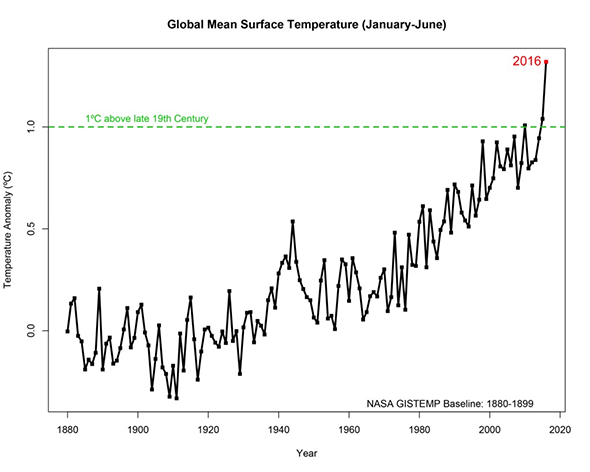If you’re not alarmed by the global climate, you’re probably not paying attention. Alternatively, it’s possible that you’re paying very close attention and you just can’t take it anymore. Data put out by NASA in March indicated that February 2016 was the most unusually warm month on record. Those anomalous temperatures were themselves no anomaly: According to a new report from the agency released on Tuesday, each month of 2016 has exceeded all previous average temperatures records. Simultaneously, and likely in response, Arctic sea ice melt has proceeded well ahead of schedule for most of the year, a trend that can accelerate other effects of global warming.
“2015 was, as some of you are aware, a very warm year,” said Gavin Schmidt, director of the Godard Institute for Space Studies in a press briefing on Tuesday. “But 2016 has blown that out of the water.” To be sure, some of that warmth—about 40 percent of the increase over last year, Schmidt said—is a product of El Niño conditions. That means 2017 is likely to be cooler, but only a little, since the other 60 percent is a consequence of factors such as melt ponds, which increase absorption of solar radiation into the surrounding sea ice. In other words, things are bad, and all indications suggest that they’re likely to keep getting worse. Climate change isn’t some distant mirage. It’s here and it’s real.
Why, then, don’t we find this information more alarming? Why do we find such unambiguous indicators so hard to accept? One explanation may be that we’ve been stuck in this record-breaking pattern for so long. “This is an extreme year,” NASA sea ice scientist Walt Meier pointed out, “but definitely in concert with a long-term trend.” The consistency with which we’re reaching unprecedented temperatures makes it feel normal—it’s a long-term trend, after all. Lingering in that pattern is the possibility that we’ve become so accustomed to climatological outliers that we’re no longer capable of registering just how extreme they really are. If you are paying attention, you’ve seen so many “most unusually warm months on record” that you’re probably exhausted by the very concept.
In between all these pronouncements of continuously broken temperature records is the continued denial of climate change from the right. OK, a few Republican lawmakers publicly accept reality, but as Ben Adler writes, relatively few of them have bothered to attend their party’s convention this week. Meanwhile, the GOP’s own issues statement on “Energy and the Environment” gestures briefly to “clean coal” and other fuel sources but makes no mention of climate change. Donald Trump departs from the party’s orthodoxy in other ways, but he arguably hews to the party establishment position here with his dismissal of global warming as a Chinese hoax. And though some of his supporters take the opposite approach, owning up to the realities of environmental degradation, their beliefs apparently aren’t enough to inspire real concern about the candidate.
Of course, it is difficult for any individual to really feel the enormity of climate change. As I’ve argued in the past, it’s often too difficult to make sense of planetary conditions in the local terms that weather allows. Attending to the weather inspires us to zero in on our own embodied experiences, which in turn makes it that much harder to make sense of larger considerations. That’s all the more pernicious when you remember that the actual record-breaking changes are relatively small, typically measured in tenths of a degree Celsius. While that’s enough to engender a whole array of climatological catastrophes, it’s not necessarily something you’d notice on your own.
There’s likely some level at which these two tendencies combine: We’re used to extreme patterns but lack a frame through which to view them as unusual or not. We expect seasonal weather changes, which makes it difficult to reconcile ourselves with rising averages. We’re not, then, quite like the mythic frog that placidly sits in water as it slowly builds to a boil. Instead, we’re one equipped with a thermometer and more than enough information to know how bad things are getting. Unfortunately, this has not spurred us to jump—to action, at least, as we have no other pot to invade. Sure, the water keeps getting hotter. We now expect it to.

NASA Godard Institute for Space Studies
Make no mistake, though, the danger is very real. As the chart above shows, temperatures this year have come in just short of 1.5 degrees Celsius over pre-industrial averages. That means we’re already perilously close to the targets set in Paris last year at the COP21 climate accords. Much as the abnormal might seem normal, it isn’t, and it’s well past time that we awoke to that reality. As NASA’s latest info dump shows, the facts of climate change are clear and incontrovertible, however difficult they may be to really accept. But much like Trump—whose endlessly accumulating offenses sometimes threaten to obscure one another—their very severity makes any one of them harder to panic over.
